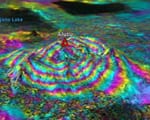Discovery adds to Fiorillo’s growing conviction that dinosaurs lived at polar latitudes year-round during the Late Cretaceous period.
LiveScience has covered the research of paleontologist Anthony Fiorillo, an adjunct associate professor in SMU’s Roy M. Huffington Department of Earth Sciences.
Fiorillo is curator of earth sciences at the Perot Museum of science and natural history. He has collected fossils throughout North America and parts of Asia, but has primarily worked in western Texas and Alaska.
LiveScience reporter Becky Oskin reported the news about the discovery of a dinosaur track site in Alaska’s Denali National Park, which shows that herds of duck-billed dinosaurs thrived there. “Huge Trove of Dinosaur Footprints Discovered in Alaska.”
EXCERPT:
By Becky Oskin
LiveScienceA “world-class” dinosaur track site discovered in Alaska’s Denali National Park shows that herds of duck-billed dinosaurs thrived under the midnight sun.
“We had mom, dad, big brother, big sister and little babies all running around together,” said paleontologist Anthony Fiorillo, who is studying the dinosaur tracks. “As I like to tell the park, Denali was a family destination for millions of years, and now we’ve got the fossil evidence for it.”
The discovery adds to Fiorillo’s growing conviction that dinosaurs lived at polar latitudes year-round during the Late Cretaceous Period, about 70 million years ago.
“Even back then the high latitudes were biologically productive and could support big herds of pretty big animals,” said Fiorillo, curator of earth sciences at the Perot Museum of Nature and Science in Dallas.
Dino dance party
The dinosaur track site, near Cabin Peak in the park’s northeast corner, has thousands of tracks from hadrosaurs, or duck-billed dinosaurs. Many of the deep tracks contain preserved skin and “nail” impressions from the plant-eating hadrosaurs.Denali dinosaur tracksPin It A hadrosaur track from Denali National Park’s amazing track site.
“This is definitely one of the great track sites of the world. We were so happy to find it,” Fiorillo said.
Fiorillo and his collaborators also found traces from birds, clams, worms and bugs intermingled with the dinosaur tracks. Other dinosaur denizens who left behind footprints in Denali were ceratopsians, therizinosaurs and the flying reptiles called pterosaurs. Ferns and redwood cones complete the picture of a rich Cretaceous ecosystem.
The muddy ground is so rumpled by footprints that the researchers were hard-pressed to pull out tracks from individual hadrosaurs. Instead, they counted each print and grouped them by size. The results were published June 30 in the journal Geology.
Follow SMUResearch.com on Twitter.
For more information, www.smuresearch.com.
SMU is a nationally ranked private university in Dallas founded 100 years ago. Today, SMU enrolls nearly 11,000 students who benefit from the academic opportunities and international reach of seven degree-granting schools. For more information see www.smu.edu.
SMU has an uplink facility located on campus for live TV, radio, or online interviews. To speak with an SMU expert or book an SMU guest in the studio, call SMU News & Communications at 214-768-7650.



 Low IQ students learn to read at 1st-grade level after persistent, intensive instruction
Low IQ students learn to read at 1st-grade level after persistent, intensive instruction Richest marine reptile fossil bed along Africa’s South Atlantic coast is dated at 71.5 mya
Richest marine reptile fossil bed along Africa’s South Atlantic coast is dated at 71.5 mya Satellite view of volcanoes finds the link between ground deformation and eruption
Satellite view of volcanoes finds the link between ground deformation and eruption Comet theory false; doesn’t explain cold snap at the end of the Ice Age, Clovis changes or mass animal extinction
Comet theory false; doesn’t explain cold snap at the end of the Ice Age, Clovis changes or mass animal extinction Real-time audio of corporal punishment shows kids misbehave within 10 minutes of spanking
Real-time audio of corporal punishment shows kids misbehave within 10 minutes of spanking